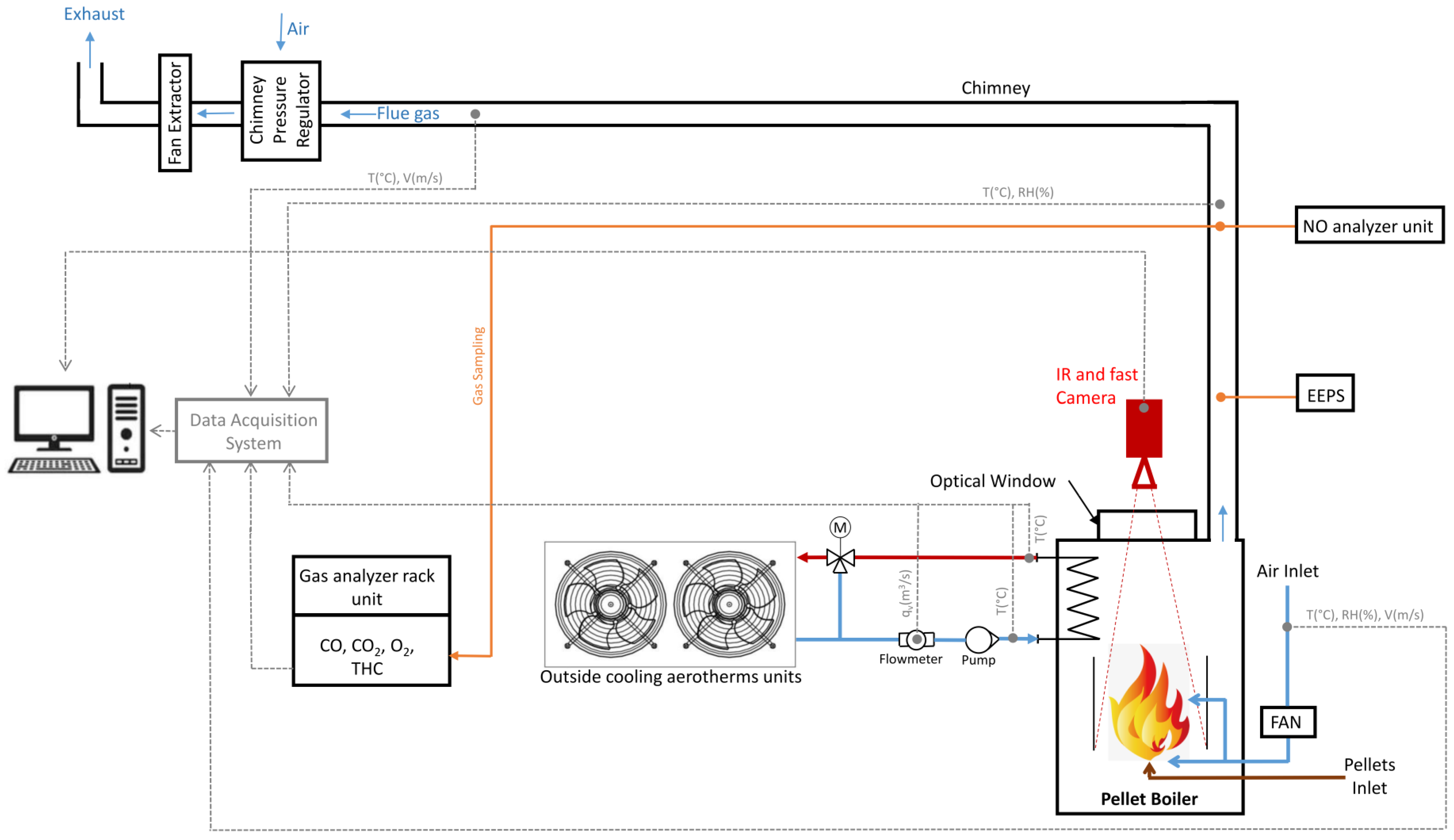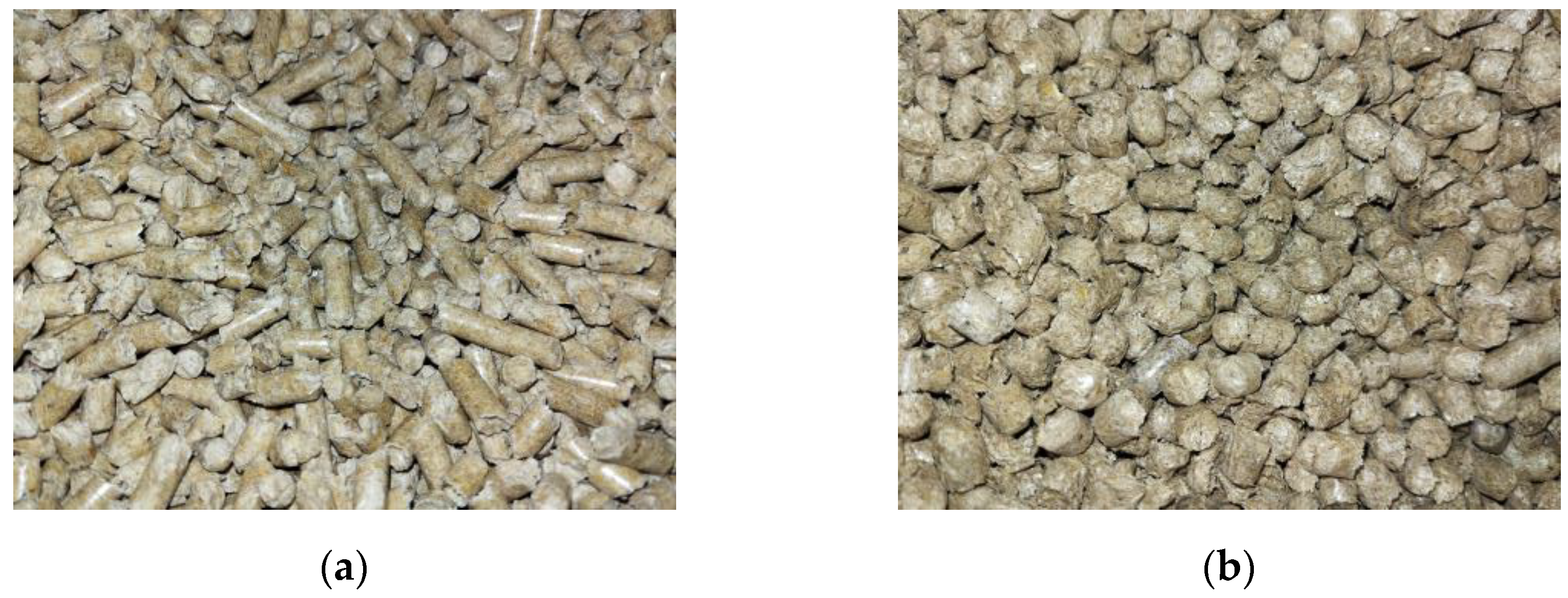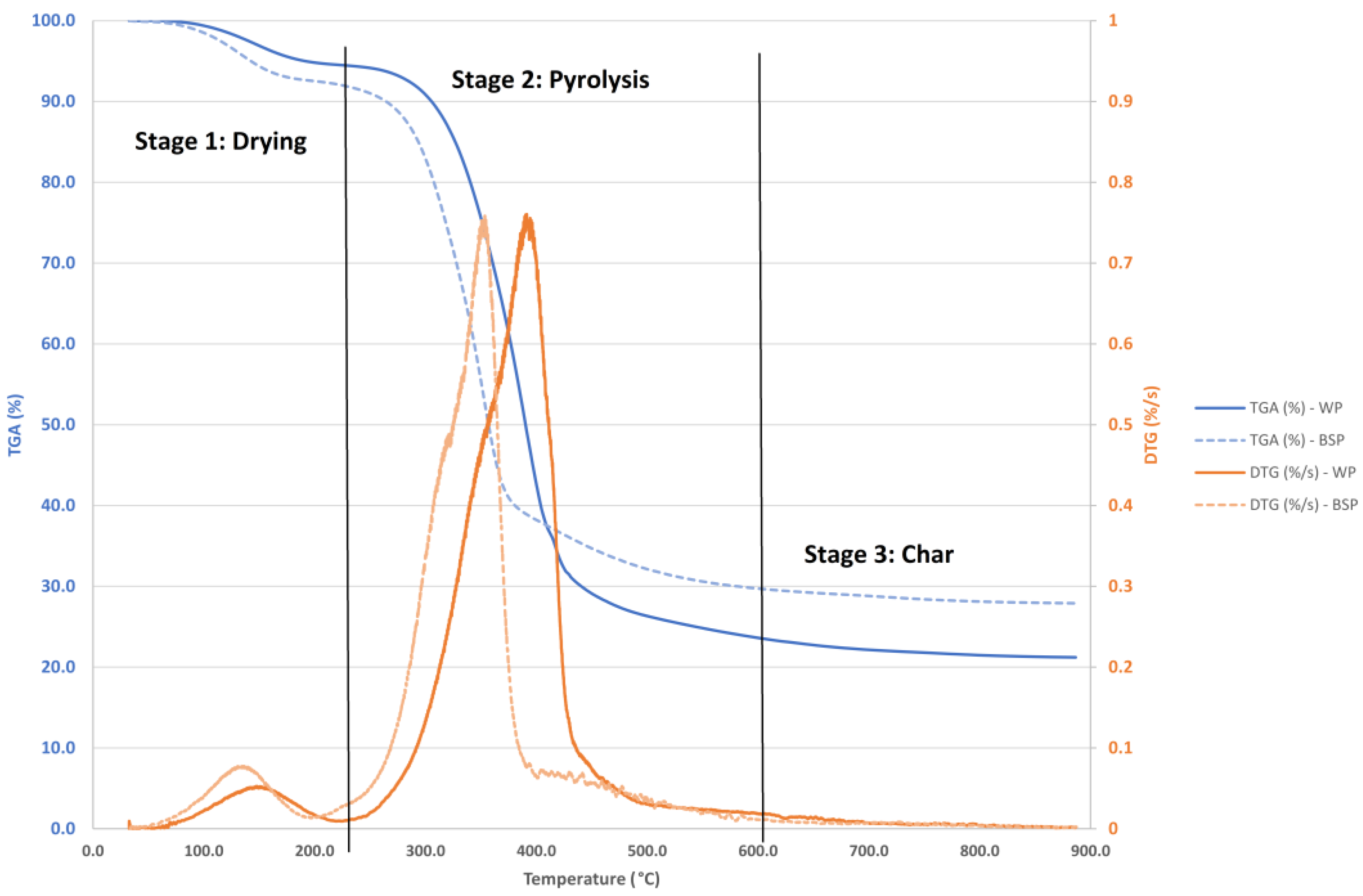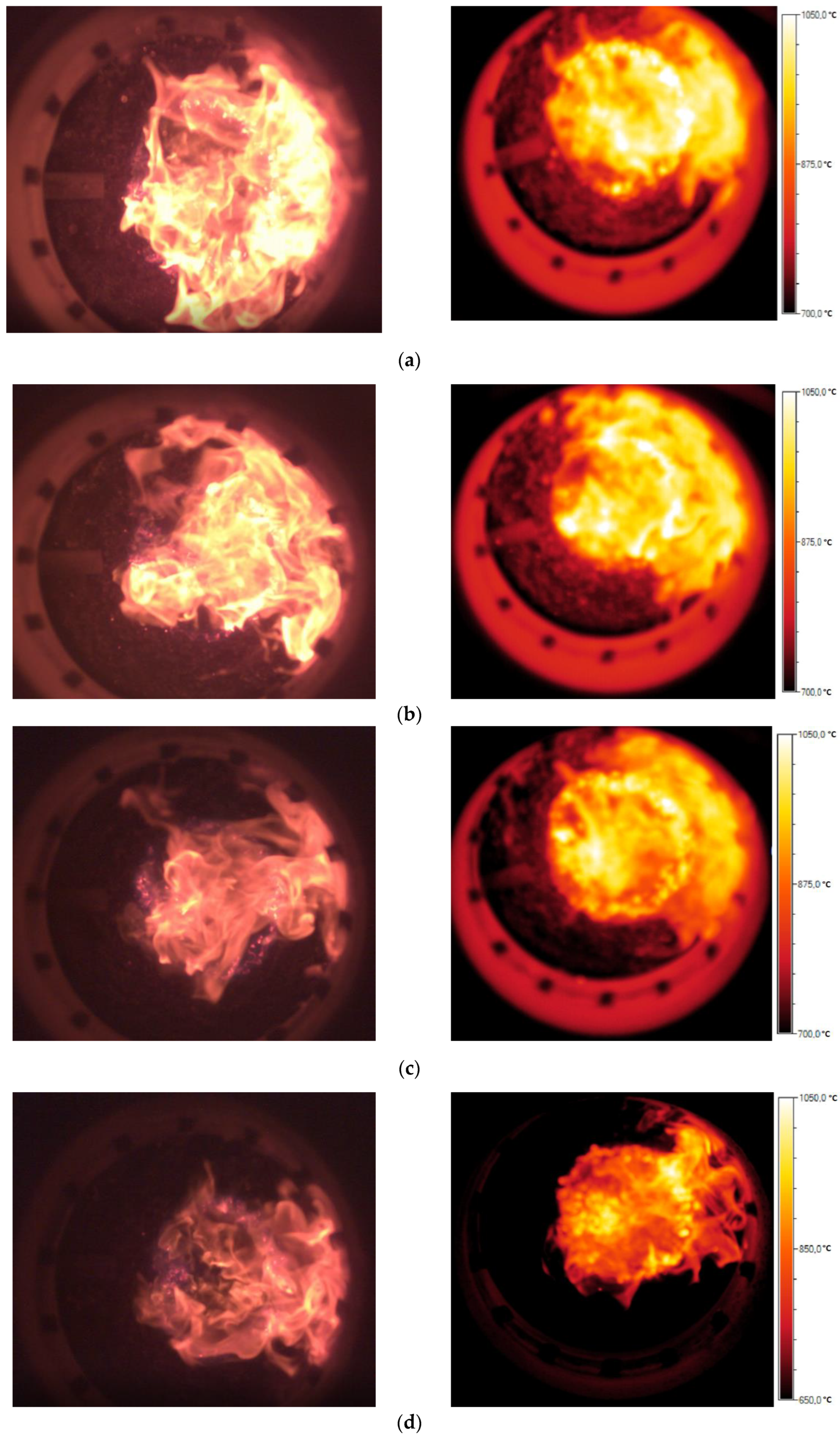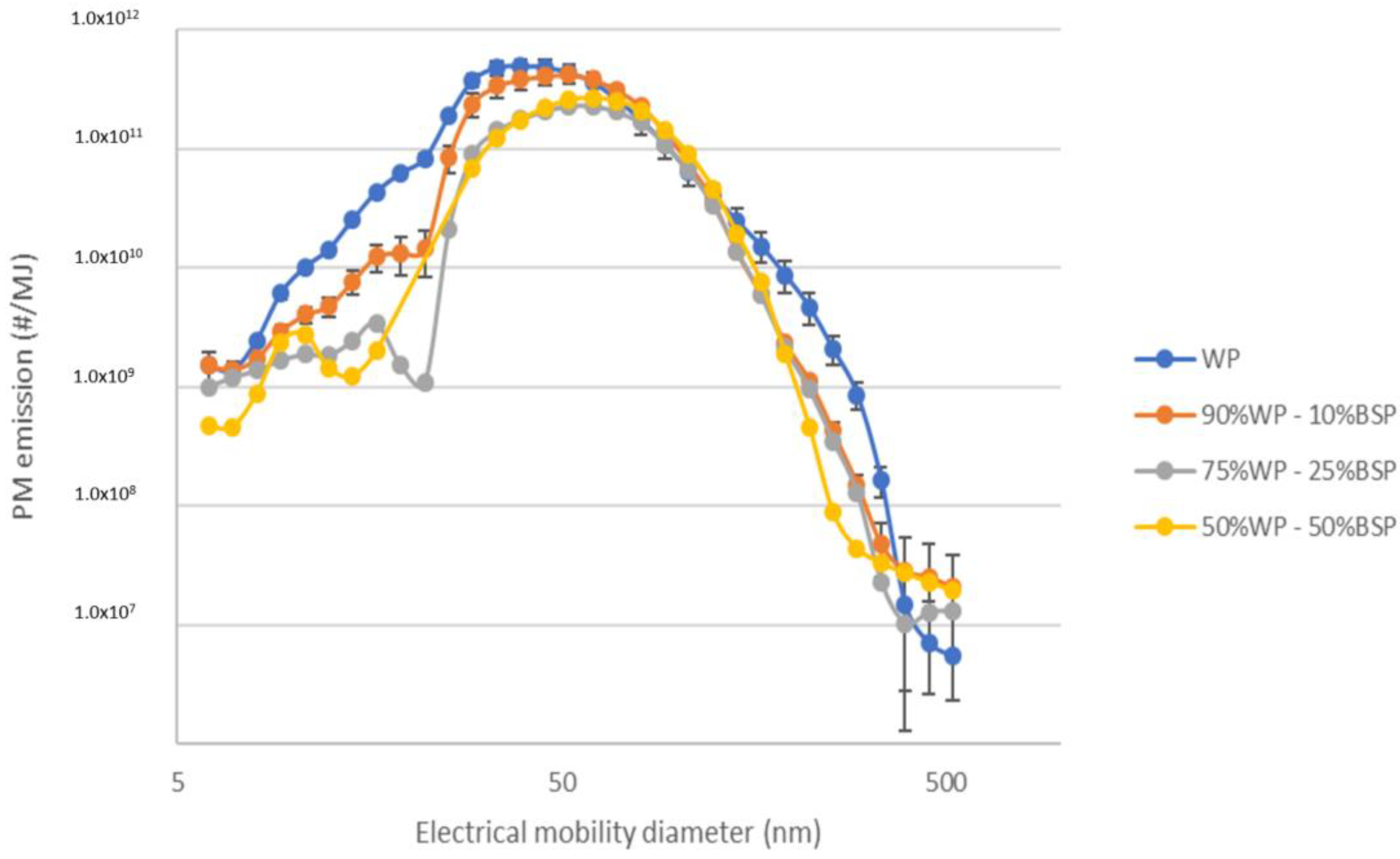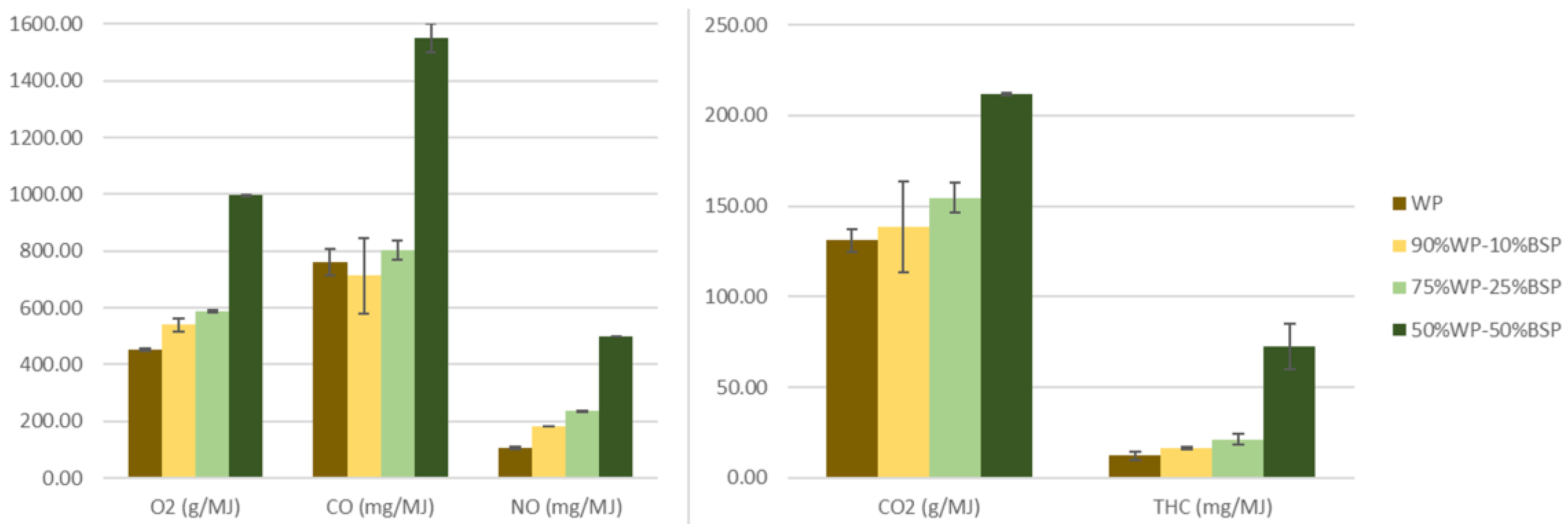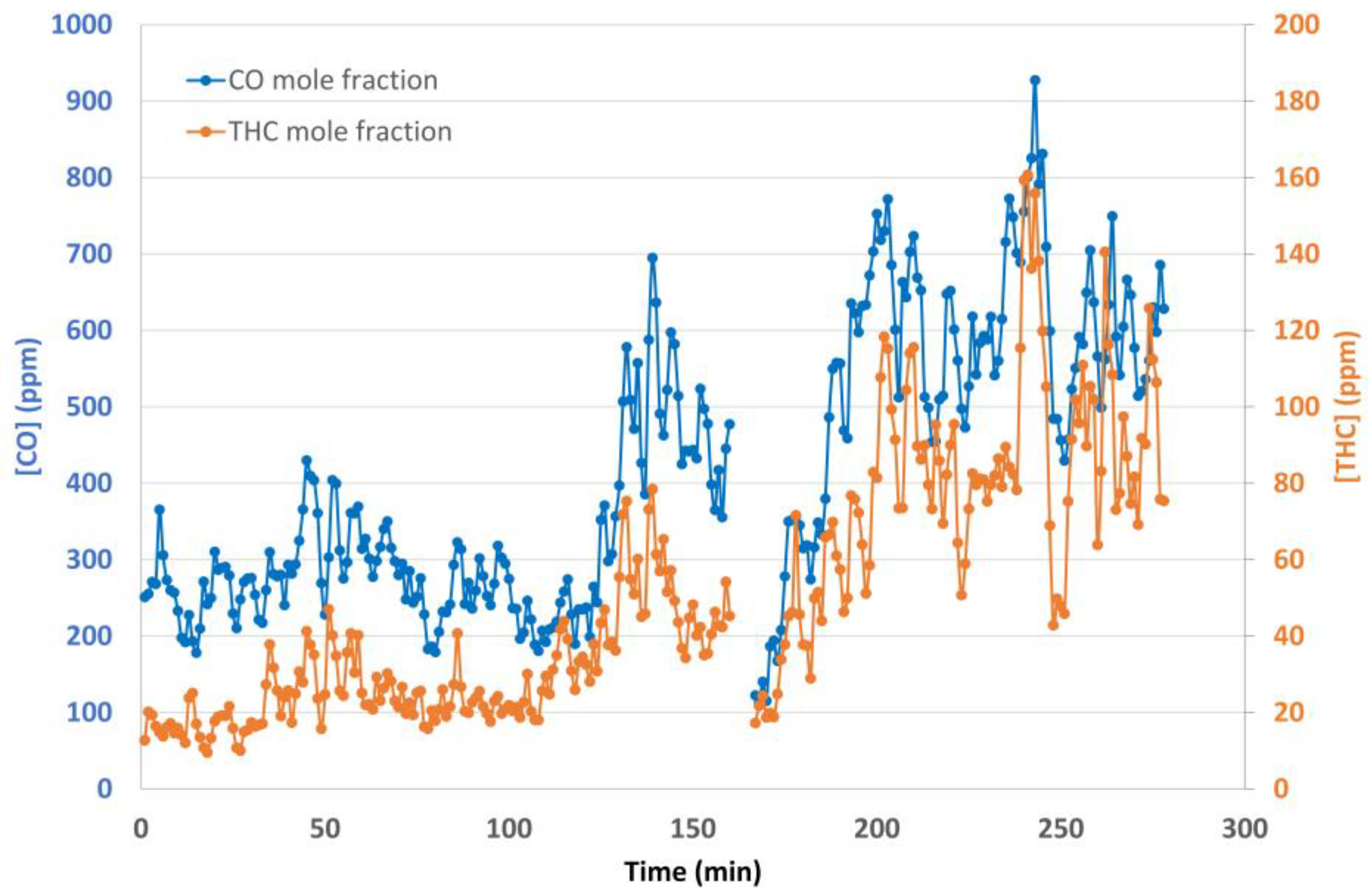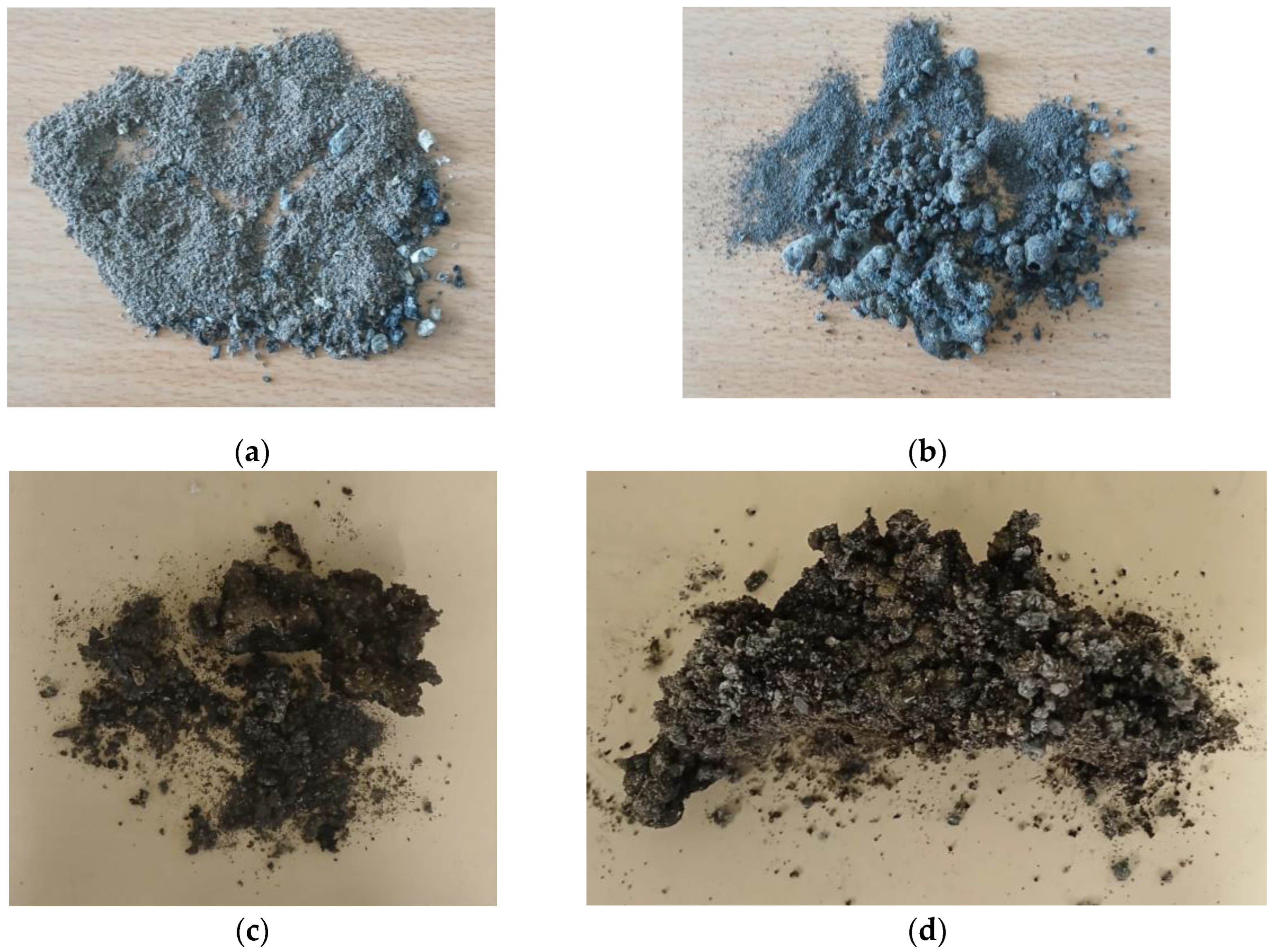1. Introduction
The year 2024 was confirmed as the hottest on record, and the first to exceed the 1.5 °C global warming threshold [
1], primarily due to greenhouse gas (GHG) emissions from fuel combustion. Developing alternative energy sources is therefore an urgent priority.
Biomass already plays a major role, offering a smaller carbon footprint than fossil fuels and representing the largest share of renewable energy production worldwide [
2]. However, wood-energy presents several drawbacks.
Wood combustion is a significant source of pollutants such as carbon monoxide (CO), nitrogen oxides (NO
x), polycyclic aromatic hydrocarbons (PAHs), and particulate matter (PM) [
3,
4,
5], all of which have well-documented impacts on public health [
6,
7].
Moreover, rising demand for greener fuels raises concerns about the sustainability of the wood sector [
8].
To address the challenges, many studies have evaluated alternative biomass sources for heat production, particularly agricultural residues.
For instance, Carroll et al. [
9] showed that wood, willow, and miscanthus pellets met emission standards, while straw-based pellets produced excessive CO, NO
x, and PM. Wheat and barley straw combustion resulted in CO emissions of 117 and 124 mg/Nm
3, NO
x of 333 and 325 mg/Nm
3, and PM of 270 and 265 mg/Nm
3, respectively. In contrast, wood pellets emitted only 25 mg/Nm
3 of CO, 142 mg/Nm
3 of NO
x, and 28 mg/Nm
3 of PM.
Vitoussia et al. [
10] compared emissions from conventional wood pellets with those from blends incorporating Cameroonian biomass residues (palm nut and coffee husk) in a domestic stove. The use of these alternative materials led again to higher pollutant levels: CO emission ranged from 543 to 648 mg/Nm
3 and PM emission from 160 to 240 mg/Nm
3, depending on the blend ratio. In comparison, wood pellet combustion emitted 193 mg/Nm
3 of CO and 35 mg/Nm
3 of PM.
Jach-Nocoń et al. [
11] evaluated the use of miscanthus, sunflower husk, and corn Stover in a 20 kW boiler with a moving grate burner. Notably, miscanthus pellets reduced emissions relative to wood, with CO at 45 mg/Nm
3 and PM at 16.1 mg/Nm
3 (versus 90 mg/Nm
3 and 21.1 mg/Nm
3 for wood). However, sunflower husk and corn Stover resulted in higher emissions.
These findings suggest that alternatives types of biomass do not always reduce pollutant emissions and may pose compatibility issues with domestic heating systems.
Therefore, the temporal profiles are rarely investigated, and the displayed results are mainly the mass concentration of pollutants, without consideration to the produced energy. Moreover, many of these studies overlook the long-term operational compatibility of such fuels with domestic heating systems and lack access to an optical window, which would allow linking flame visualization to pollutant emissions or boiler operation.
The present study aims to experimentally assess whether barley straw pellets (BSPs), an agricultural waste product, could be used as a partial substitute for wood pellets (WPs) in domestic biomass boilers without requiring any system modifications.
The literature review indicates that only a few studies deal with the combustion of BSPs, showing higher pollutant emissions [
9]; consequently, mixtures with BSPs and WPs will be investigated.
Moreover, the boiler is equipped with a two-stage air injection. The addition of secondary air is known to reduce pollutant emissions. For instance, Holubčík et al. [
12] reported a 40% reduction in CO emissions and a 5% decrease in NO
x emissions when transitioning from combustion using only primary air to a configuration in which 25% of the total air is supplied through a secondary inlet positioned above the flame. The experimental setup used for this study was also investigated in a full primary air configuration with only WPs [
13].
Therefore, after characterization of the pellets by calorimetric bomb and Thermo-Gravimetric Analysis (TGA), this study investigates how these mixtures affect energy production and pollutant emissions. Three mixtures with wood pellets (WPs) are studied, with 10, 25, and 50%, in mass, of barley straw pellets (BSPs), and are compared to classical WPs. Each component of the mixture was weighed with a balance (range: 0–12 kg, accuracy: 0.1 g) before being blended.
Additionally, infrared (IR) and high-speed cameras were installed above the furnace to monitor the flame characteristics. The goal is to determine whether flame color, shape, and qualitative temperature data can provide meaningful insights into the combustion process. Some previous studies on gas burners [
14,
15,
16] have shown that relevant information can be extracted from the analysis of two-dimensional visible flame images. In those works, the authors present newly developed methods to characterize flames from their visualizations, achieving cost-efficient estimation of parameters such as flame temperature, radical species concentration, or geometric parameters.
The novelty of this work lies in the combination of long-duration experiments, flame visualization techniques, and emission measurements, providing a comprehensive assessment of the feasibility of using barley straw pellets in domestic boilers.
2. Experimental Setup
2.1. Boiler Description
A schematic of the test bench and its components is shown in
Figure 1.
Experiments were performed in a 10 kW domestic biomass boiler equipped with an underfeed burner. Pellets were automatically fed into the combustion chamber by a screw conveyor positioned below the flame, with injections lasting 4 s every 12 s.
Combustion air was supplied at two points: primary air was injected through the underfeed burner, while secondary air was introduced via nozzles positioned above the flame.
Several parameters were continuously monitored at both the air inlets and the flue gas outlet, as indicated by the grey dashed line in
Figure 1:
- -
Temperature (T): class 1 type-T thermocouples (range: −40–350 °C, accuracy ±0.5 °C);
- -
Relative humidity (RH): capacitive sensor (range: 5–95%, accuracy: ±0.1%);
- -
Air velocity (V): propeller anemometer (range: 0.3–35 m/s, accuracy: ±0.1 m/s).
All measurements were recorded at a frequency of 1 Hz.
The boiler was also equipped with a gas-to-water heat exchanger, consisting of a network of tubes surrounding the combustion chamber. A hydraulic circuit transferred the recovered heat to an external exchanger, which dissipates the stored thermal energy, thereby ensuring the energy balance of the test bench. This hydraulic loop was also instrumented with class 1 type-T thermocouples and a flowmeter (range: 0.1 to 50 L/min) to calculate the thermal power transferred to the water using the following expression:
where
- -
P is the power transferred to the water (W),
- -
qm is the mass flow rate of water (kg/s),
- -
cp water is the specific heat capacity of water (J/(kg·K)),
- -
∆T is the temperature difference between water inlet and outlet (K).
2.2. Gaseous Emissions Measurement Techniques
Gaseous emissions were characterized using automatic gas analyzers installed in the chimney.
The mole fractions of CO, CO2, and O2 were measured with an ENVEA MIR9000 infrared spectroscopy analyzer, with measurement ranges of 0–5000 ppm, 0–20%, and 0–25%, respectively. Infrared spectroscopy detects the absorption of specific wavelengths, linked to molecular vibrations, by molecules present in the flue gases.
Total HydroCarbons (THCs) were quantified using an ENVEA Graphite 52 M Flame Ionization Detector (FID) (Poissy, France), with a measurement range of 0–10,000 ppm. In this method, hydrocarbons in the flue gases are burnt in a hydrogen–helium flame, producing ions that generate a current proportional to the pollutant concentration.
After calibration with standard gas cylinders, the measurement accuracies achieved were ±2% for CO, CO2, and O2 mole fractions, and ±1% for THCs.
All pollutants were sampled at the same chimney location via a heated sampling line to prevent condensation. Upstream of the analyzers, the system includes a condensate trap and a particulate filter to remove residual water droplets and solid particles.
NO concentration was measured separately using an electrochemical cell connected to another heated line with a particle filter. This technique provides an accuracy of ±5 ppm and a resolution of 1 ppm. NO2 was also measured, but was closed to 1 ppm for all the tests. Results are not described below as they correspond to the detection limit.
All gas analyzers operated at a data acquisition frequency of 1 Hz.
2.3. PM Emissions Measurement Techniques
Particulate matter (PM) emissions were characterized using an Engine Exhaust Particle Sizer (EEPS, TSI, Marseille, France) installed in the chimney, with gases sampled at 10 L/min.
This instrument provides the particle size distribution at an operating frequency of 1 Hz, from which the median diameter (d50) and the total particle number concentration are derived.
The EEPS covers a size range of 5–523 nm, distributed across 32 size channels. The method relies on the electrical mobility classification of particles [
17]. Particles are first electrically charged, then pass through a column of electrometers. Smaller particles, due to lower inertia, impact the early electrometers, while larger ones move further along the column, enabling size-resolved detection.
A dilution system with a 1:100 ratio was used to avoid electrometers saturation, and concentrations were corrected accordingly. An air dryer was installed upstream of the sampling line to prevent condensation within the device.
Although the EEPS was originally designed for internal combustion engine emissions [
18,
19,
20], similar instruments based on the same measurement principle have been successfully applied to biomass combustion studies [
21,
22].
2.4. Flame Visualization
Infrared (IR) and high-speed cameras were used to visualize and qualitatively compare the flame characteristics through an optical window added to the boiler (see
Figure 1).
The high-speed camera, operating at 100 frames per second (fps) and equipped with a CMOS LUX1310 image sensor, recorded at a resolution of 1280 × 1024 pixels, sufficient to capture the entire flame with a suitable level of details.
Flame analysis was performed with Flame Tracker software (v1.2.0) [
23], which computes the real-time flame area and distinguishes yellow and red regions. The yellow area is generally associated with soot presence [
24].
Each pixel of the image is converted into Red, Green, and Blue values, and predefined thresholds were applied to determine whether it may be considered part of the flame. The resulting images were converted into a binary format, and their minimum and maximum locations along the horizontal direction are considered by Flame Tracker software as the flame edges. After spatial calibration (pixels per centimeter), the flame length is calculated as the distance between the two detected flame edges, and the flame area is computed accordingly.
By maintaining constant camera settings and processing parameters across all the tests, a qualitative comparison of flame morphology and color were performed according to the pellet mixtures.
The IR camera, operating at 30 Hz with a resolution of 640 × 480 pixels and a spectral range of 8–14 µm, was also used. A fixed region of interest (ROI) was selected, and the averaged flame temperature was computed. The camera settings were also kept constant to ensure a meaningful comparison between the different fuels.
2.5. Thermogravimetric Analysis
Thermogravimetric analysis (TGA) was performed using a SETARAM LabSys Evo device (Lyon, France), providing a temperature accuracy of ±1 °C and a weight accuracy of ±0.01%.
Biomass samples of 30 mg of biomass were heated from 30 °C to 900 °C at a rate of 50 °C/min under a constant nitrogen flow of 50 mL/min, preventing complete combustion and isolating the pyrolysis phase.
These conditions were chosen to approximate real boiler operation without introducing combustion effects.
3. Fuel Characterization
Two types of biomass pellets were used in this study. Pellets are cylindrical units of compacted biomass, typically 6–8 mm in diameter and 3 to 40 mm in length. Pelletization improved the fuel properties of biomass, enhancing its energy density and handling properties [
25].
For wood pellets (WPs), production involves a drying step followed by high-temperature compression. Although WPs are generally produced from wood industry residues, their manufacturing requires a significant energy input. Their properties are regulated by European standards [
26], ensuring consistency and quality.
The second biomass type investigated is barley straw pellets (BSPs), an agricultural by-product that requires no additional land use. Consequently, their utilization could reduce reliance on wood resources.
A visual comparison of the two pellet types is shown in
Figure 2, highlighting differences in shape.
However, BSP physical properties are different from those of wood and are not standardized.
Table 1 compares the main properties of WPs (from standards [
26]) and BSPs (from the literature [
27,
28,
29]).
The review highlights, first, the lack of consistent data for BSPs, and second, the significant variability of reported values.
Among the available data, barley straw pellets generally meet WPs’ standard for density, and are close to or slightly above the standard for lower heating value (LHV) and moisture content. However, they consistently fail to meet the strict ash content requirements. Their durability index is also close to the standard requirements.
Other physical properties include thermal conductivity and the retractability coefficient. Wood thermal conductivity is known to vary according to the wood’s nature. Typically, dry wood has a thermal conductivity between 0.13 and 0.2 W/m.K. The retractability coefficient varies between 0.11 and 0.26% by 1% of modification of humidity for the radial axis and between 0.21 and 0.44% for the tangential axis.
Some laboratory measurements were also performed to compare the properties of the pellets used in this study with those reported in the literature.
- -
The Higher Heating Value (HHV) was determined using a bomb calorimeter under constant volume. One gram of pellet was combusted in pure oxygen at a pressure of 34 bar.
- -
The moisture content was measured on a working basis by weighing the samples before and after 48 h in a drying chamber at 105 °C.
- -
The ash content was determined through a two-step thermal treatment in a muffle furnace: an initial one-hour stage at 250 °C followed by a three-hour stage at 550 °C. Then, the ash content was calculated as the ratio of ash weight to the initial sample weight.
- -
The envelope density of the two pellets types was measured using a GeoPyc 1360 instrument (Micromeritics, Norcross, GA, USA), which estimates sample volume of solid samples through a displacement method using a non-penetrating, free-flowing powder. The envelope volume was calculated from the displacement data, and envelope density was obtained by dividing sample mass by this volume.
Each test was repeated three times for both WPs and BSPs. Results are reported in
Table 2 and are consistent with the literature [
28].
BSPs exhibit lower HHV and density, and higher moisture and ash contents compared to WPs. Nevertheless, BSPs remain within WP standards for most properties, except for ash content. The small standard deviations observed confirm the homogeneity of the pellet batches.
In addition, a Thermo-Gravimetric Analysis (TGA) was performed on both pellet types to monitor mass loss with temperature increase.
From TGA data, the first Derivative ThermoGravimetry (DTG) was calculated to highlight decomposition phases.
The TGA and DTG curves for both fuels are shown in
Figure 3, revealing three distinct phases:
Drying (65–215 °C): small mass loss due to moisture evaporation.
Pyrolysis (200–670 °C): devolatilization and significant mass loss.
Char stabilization (>670 °C): minimal mass change in remaining solid residue.
Table 3 summarizes temperature ranges, mass losses, and residual mass for each stage. BSPs show larger mass loss during drying (due to higher moisture content), and a higher final residue (reflecting higher ash content). WPs, in contrast, exhibit greater mass loss during pyrolysis, which could indicate higher volatile release and potentially greater pollutant emissions.
4. Analysis of the Combustion in the Boiler
4.1. Experimental Protocol
As described earlier, three pellet mixtures were tested and compared to pure wood pellets (WPs). For WPs and the blends containing 10%, 25%, and 50% of barley straw pellets (BSPs), three tests of three hours each were conducted.
These tests focused exclusively on the steady operating phase of the boiler, defined as the period during which operating parameters remained stable (with deviations below 5% from the temporal mean).
During this steady phase, boiler operating parameters and concentrations of CO, CO2, O2, and THC were continuously recorded using gas analyzers.
For other instruments, acquisition periods were scheduled every 30 min to protect them against clogging. Measurement durations were set to 5 min for the EEPS and NO analyzer, and 30 s for the cameras.
This protocol allowed the influence of operating duration on both pollutant emissions and boiler performance to be assessed.
To further investigate temporal variations, two additional tests were carried out with WPs and the 50% BSP mixture, lasting one and five hours, respectively. In these cases, only boiler operating parameters and gaseous emissions were recorded. Results are discussed in
Section 4.4.
All reported data correspond to mean values calculated from temporal averages of each test. Maximum deviations from the mean are used as uncertainty estimates and are displayed as error bars in the figures.
4.2. Boiler Functioning
The mean values of boiler operating parameters are given in
Table 4.
Results show that both the power transferred to water and the flue gas temperature decrease with increasing BSP content in the mixtures.
The reduction reaches up to 11% for flue gas temperature and 25% for transferred power to water when comparing with pure wood pellets to the 50% BSP mixture. These trends are consistent with the lower heating values of BSPs (see
Table 1 and
Table 2).
A slight increase in flue gas relative humidity is also observed with increasing BSP content.
Flame visualization provides further insights into how fuel composition influences combustion.
Figure 4 illustrates flame shape and color from the high-speed camera and flame temperature distribution from the IR camera, recorded 30 min after reaching steady-state. Time-averaged values across all the tests are summarized in
Table 5.
Deposition on the optical window is observed over time. To minimize its impact on the analysis, only data from the first 120 min of operation, before significant deposition, are considered.
Clear differences are observed between the mixtures. Flame area is decreasing significantly with increasing BSP content, from 639 cm2 for WPs to 169 cm2 for the 50% BSP blend (a 74% reduction). This reduction is correlated with a lower energy production.
The proportion of yellow flame area, associated with soot, is also decreasing, from 34% for WPs to only 2% for the 50% BSP mixture. These results are compared with particulate matter (PM) emissions in
Section 4.3.
IR images also show morphological differences, particularly area reduction.
A decrease in mean flame temperature from 944 °C (WPs) to 825 °C (50% BSPs), calculated in the whole flame area, is also noticeable and can be explained by the lower LHV of the BSPs.
The emissivity of the camera was kept constant (ε = 1), so the displayed temperatures remain qualitative and are used to compare flames with one another. The maximum deviations from the mean remained very low across the three tests.
Overall, reductions in generated power seem to be correlated with decreases in both flame area and mean flame temperature.
The WP flame temperature measured in this study is comparable to values reported in a previous work [
30], where temperature mapping was conducted with thermocouples inside a 30 kW wood pellet boiler. Although both techniques give similar results, IR thermography offers the advantage of being a non-intrusive method and avoids radiative heat loss issues associated with thermocouples.
4.3. Pollutant Emissions
The size distribution of the emitted particulate matter (PM) was measured for the three pellet mixtures with BSPs and compared to pure WPs. Results are presented in
Figure 5 and
Table 6.
A reduction in PM concentration in the chimney is observed, with decreases up to 65% for the 50% BSP mixture. However, when normalized by the produced energy, total PM emissions and particle size distribution for the 25% and 50% BSP mixtures are similar, both showing about a 50% reduction compared to WPs. The median particle diameter increases from 44.1 nm to 61.0 nm.
Furthermore, the particle size distribution of the emitted PM changes with the addition of BSPs: the emission peak becomes less pronounced and shifts towards larger diameters, as shown in
Table 6. After this peak, the particle concentration decreases continuously for WP combustion. Therefore, an increase in the emission of larger particles is noticeable in the mixtures, starting at a diameter exceeding 390 nm.
It also appears that the content of coarser particles is higher in the mixtures. Consequently, only one test was performed on the 25% and 50% BSP mixtures to protect the dilution system and the EEPS.
These observations correlate with the reduction in yellow flame area recorded by the high-speed camera, since soot is the main source of PM in biomass combustion. The assessment of yellow flame area seems to be a good indicator of the PM emissions. Therefore, soot aggregates typically in the range 10–100 nm in diameter. The good agreement between diagnostics confirms this interpretation.
Gaseous pollutant emissions are shown in
Figure 6. They are normalized to the energy produced and to 13% of O
2, in order to comply to the EN 303-5 standard [
31].
Several analyses can be drawn from the data.
- -
The CO2 and O2 concentrations slightly increase with the BSP proportion in the pellet mixtures.
- -
NO emissions increase with BSP content, from 107.6 mg/MJ (WP) to 498.7 mg/MJ (50% BSP), on average. The formation of fuel-NO can be explained by a higher nitrogen content in the elemental composition of BSPs, as the measured flame temperatures are not high enough to favor thermal-NO formation [
3]. This hypothesis is supported by literature data [
27,
28] showing that barley straw contains at least 50% more nitrogen than wood.
- -
CO emissions decrease slightly for the 10% BSP mixture, from 760.7 mg/MJ (WP) to 712.8 mg/MJ, but rise sharply for 50% BSPs (+104%).
- -
THC emissions remain almost unchanged; an increase of 2 and 4 mg/MJ for 10% and 25% BSP, respectively, but a substantial increase for the 50% BSP mixture (+490%).
Overall, the most favorable blends appear to be 90% WP–10% BSP and 75% WP–25% BSP.
The 10% mixture reduces the CO and PM emissions, with only minor increases in NO and THC emissions. The 25% BSP mixture enables significant WP substitution and reduces particulate matter emissions (in the range 5–523 nm), and the CO emissions exhibit a limited increase. However, more important rises in THC and NO emissions are measured. Finally, the 50% BSP mixture results in unacceptable increases in CO, NO, and THC emissions.
All mixtures comply with EN 303-5 CO limits. In the worst-case scenario (50% BSP), the CO emissions have reached 316 mg/m3, which remains below the 400 mg/m3 standard threshold for the highest performance class of residential boilers.
The slight reduction in CO emissions with the 10% mixture can be explained by the BSPs’ lower density (
Table 2); with a constant pellet volume feed rate, the air–fuel ratio becomes more favorable. However, this hypothesis does not explain why CO and THC emissions are higher for 25% mixture, and even more so for 50% BSPs.
Consequently, an investigation of the temporal gaseous emissions is carried out to explain this behavior.
4.4. Temporal Evolution of a 50% WP–50% BSP Mixture
To better understand this phenomenon, mean CO and THC mole fractions were measured for one-hour and five-hour tests with the 50% BSP mixture, and compared with WPs (
Table 7).
For the one-hour test, with 50% BSPs, CO emissions are lower than pure WPs, while THC emissions only describe a slight increase. It is following the same trend as the 10% BSP mixture, as reported in
Figure 6.
After five hours, however, both CO and THC emissions are increasing sharply. No such time-related difference is observed for pure WP combustion.
Moreover,
Figure 7 presents the temporal profiles of CO and THC concentrations during the five-hour test for the 50% BSP mixture. A significant increase in emissions is observed after more than one hour of operation. Specifically, the temporally averaged concentrations of CO and THC during the first hour are 284 ppm and 22 ppm, respectively. During the last hour, these values rise to 617 ppm and 90 ppm, representing increases of 117% and 310% for CO and THC emissions, respectively, compared to the first hour. This significant rise in CO and THC concentrations indicates degradation of combustion quality over time.
Furnace inspection has revealed clear differences in bottom ash residues. With BSP blends, sintering phenomena are observed, becoming more pronounced at higher BSP content and longer durations (
Figure 8).
In panel (a), corresponding to WP combustion, only fine ash particles are visible. In panels (b) and (c), representing 25% and 50% BSP mixtures after 3 h of test, solid agglomerates begin to appear with an increasing proportion. Finally, panel (d) shows sintered ash residues exclusively, for the 50% BSP mixture after five hours of the test.
Therefore, a high proportion of BSPs in the pellet mixture leads to ash sintering in the furnace, which causes a modification of the combustion parameters and an increase in the gaseous pollutant emissions. These results suggest that excessive BSP content, with a higher ash content (
Table 2), promotes ash sintering in the furnace, obstructing air inlets and altering combustion. This can explain the observed increases in gaseous emissions and the reductions in flame area and energy production.
5. Conclusions
This study experimentally assessed the feasibility of using barley straw pellets (BSPs) as a partial substitute for wood pellets (WPs) in a domestic underfeed biomass boiler, without requiring any modifications. The impact on pollutant emissions and boiler performance was evaluated through several diagnostic tools: infrared spectroscopy for CO, CO2, and O2, Flame Ionization Detector for THC, electrochemical cell for NO, electrical mobility classification for the PM size distribution, as well as optical flame visualization.
Three mixtures (10%, 25%, and 50% BSP by mass) were compared to pure WPs under steady-phase operating conditions.
Key findings are as follows:
A 25% BSP mixture can be successfully used without boiler modification, maintaining stable combustion. In addition to reducing substantially the WP content, it drastically reduces the PM emissions in the measured range (5.32–532 nm), by about 50% in number. However, it leads to a moderate increase in gaseous pollutants, especially for NO with increases of 128 mg/MJ.
A 10% BSP mixture slightly reduces CO and PM emissions. The CO emissions are reduced (6%) with only slight increases in NO and THC emissions, respectively, of 80 and 2 mg/MJ. The PM emissions decrease 13% for an equivalent heating energy, compared to WPs. However, it offers a low-impact substitution scenario.
A 50% BSP mixture also reduces drastically the PM emissions in the measured range (65%). However, it causes a sharp rise in CO, NO, and THC emissions, explained by ash sintering in the furnace. It should seal the primary air inlet and affect the combustion process as suggested by the flame area and temperature.
In conclusion, BSPs can partially replace WPs in underfeed boilers at least up to 10%, with clear environmental benefits—particularly regarding PM emissions—but with limitations at higher proportions. While these conclusions are specific to the tested underfeed burner technology, they may be extended to similar domestic systems. Intermediary mixtures should be investigated to identify the optimal BSP portion. Therefore, it would be interesting to investigate the behavior of BSPs in other heat production systems with other types of burners.
Further studies should explore the ash sintering phenomenon in more detail, to identify strategies to mitigate it and enhance the suitability of barley straw for use in domestic boilers equipped with underfeed burners. Instead of blending the two types of pellets, it would also be interesting to manufacture pellets with similar contents of mixture and to evaluate the impact on ash sintering. It should affect the combustion behavior.
